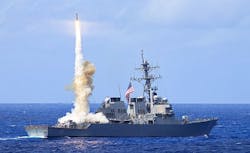The aircraft carrier has reigned supreme as the most powerful surface warship for nearly 70 years, and for that long has been the cornerstone of U.S. naval power. The big question is how much longer can the carrier retain its top position?
The answer is probably not much longer, and for a variety of reasons.
First, the ocean is a big place. It takes up 71 percent of the planet's surface area, and covers 37 times more of the Earth than does the United States. The U.S. Navy operates 12 aircraft carrier battle groups. I ask you, how can the Navy cover an area so large with just 12 carriers?
The simple answer is it can't ... not really, and certainly not today as the maritime forces of nations competitive with, or hostile to, U.S. military and political interests continue to improve.
Certainly there are powerful naval warships other than the aircraft carriers. There are the fleet ballistic missile submarines, each of which that could destroy more than 20 large cities. There are the missile-defense destroyers that -- at least on a good day -- can destroy enemy ballistic missiles in flight. There are the nuclear-powered fast-attack submarines that could take on any enemy surface warship or submarine.
Still, in addition to maritime capabilities, naval power also boils down to a game of numbers.
At the end of World War II the U.S Navy was operating 6,768 ships of all types, not all of them warships. By the end of the Korean War in 1954 that number had decreased to 1,113. By the height of the Vietnam War in 1968 the Navy operated 932 ships -- a questionable number to cover all the world's oceans.
Related: Navy Ford-class carriers to lead the way with electric catapults, UAVs, and laser weapons
So what about today? At the end of 2016 the U.S. Navy operated 275 vessels. That's just 4 percent of the World War II high;, 25 percent of Korea; and 30 percent of Vietnam. The last time the U.S. Navy operated more than 600 ships was 1973. The fleet consisted of 594 ships in 1987 at the height of the Cold War during the Reagan Buildup.
Today there's a strong Chinese navy centered on vital shipping lanes in the South China Sea; the Russian navy is growing since its post-Soviet low, and new challenges are anticipated from India, Iran, North Korea, and others.
It doesn't take a genius to see that the U.S. Navy simply doesn't have enough ships today to go-round ... not if the Navy intends to maintain itself as a global maritime power. In my lifetime I doubt if we'll see a fleet anywhere the size of what we saw 30 years ago.
So where do we go from here? There are signs that we're making ready to bid the old Navy good-bye, and say hello to a new era of distributed forces and automation that's no longer centered on large capital warships like aircraft carriers, and that could bring the best of technology to bear in making up for a lack of numbers. Rest assured, the big powerful warships will play a role, too.
Here are five reasons we may be at the start of a new naval era.
1. New ballistic missile submarines. Just last week the Navy awarded a $5.1 billion contract to General Dynamics Electric Boat to complete the design of the lead Columbia-class submarine, the nation's next-generation nuclear-powered ballistic missile submarine. Twelve of these vessels will be built to carry the latest Trident D5 nuclear missiles, as well as a variety of cruise missiles and other munitions. The size of this submarine also could make it a candidate to carry a variety of unmanned underwater and unmanned aerial vehicles for covert surveillance and attack.
2. New aircraft carriers. The Navy commissioned the first of 10 Ford-Class aircraft carriers last summer. This ship will have all-electric catapults, new sensors, and the ability to support and operate squadrons of unmanned aerial vehicles (UAVs) for surveillance and attack. This ship is a model of systems automation, and likely will see the first generations of future Navy unmanned fighter and bomber aircraft.
3. Extra-Large Unmanned Underwater Vehicles (XLUUV). Also last week, the Navy awarded contracts to Lockheed Martin Corp. and the Boeing Co. to design prototypes of the Extra-Large Unmanned Underwater Vehicles (XLUUV) -- a future autonomous submarine with a diameter of at least seven feet that will operate as a clandestine mothership that launches and recovers UUVs, UAVs, and other kinds of sensor payloads. These large unmanned submarines will operate for months at a time, maybe longer, and will be able to deploy weapons and sensors secretly to keep an enemy off balance.
4. Cross Domain Maritime Surveillance and Targeting. The U.S. Defense Advanced Research Projects Agency (DARPA) has launched a program called Cross Domain Maritime Surveillance and Targeting (CDMaST) that could lead to new doctrines in naval warfare and sea control. The idea revolves around real-time secure networks of manned and unmanned aircraft, surface ships, and submarines able to attack and defend vast areas of the world's oceans to hold enemy ships and submarines at risk over wide contested areas.
5. Sleeper weapons that seek targets of opportunity. DARPA also is carrying out the Upward Falling Payloads (UFP) program, which seeks to develop sensors, as well as lethal and non-lethal weapons that would be placed secretly on the ocean floor, and activated months or years later to engage enemy forces at crucial moments.
It's unlikely we'll ever see a U.S. naval fleet to match the sizes of yester-year, yet some of the new maritime technologies and platforms in development might help to even the odds. In future years we might look back on the Navy we see today as the Old Navy.
Ready to make a purchase? Search the Military & Aerospace Electronics Buyer's Guide for companies, new products, press releases, and videos

